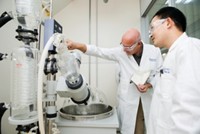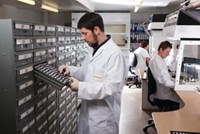Advertisement
Grab your lab coat. Let's get started
Welcome!
Welcome!
Create an account below to get 6 C&EN articles per month, receive newsletters and more - all free.
It seems this is your first time logging in online. Please enter the following information to continue.
As an ACS member you automatically get access to this site. All we need is few more details to create your reading experience.
Not you? Sign in with a different account.
Not you? Sign in with a different account.
ERROR 1
ERROR 1
ERROR 2
ERROR 2
ERROR 2
ERROR 2
ERROR 2
Password and Confirm password must match.
If you have an ACS member number, please enter it here so we can link this account to your membership. (optional)
ERROR 2
ACS values your privacy. By submitting your information, you are gaining access to C&EN and subscribing to our weekly newsletter. We use the information you provide to make your reading experience better, and we will never sell your data to third party members.
Business
A Market Grows, Block By Block
Pharmaceutical building-block business attracts firms from across the globe
by Michael McCoy
May 2, 2011
| A version of this story appeared in
Volume 89, Issue 18

When Derek Lowe, author of the In the Pipeline drug discovery blog, wrote a post about laboratory chemical suppliers last year, complaints from commiserating chemists soon flooded his comments section. Buying building-block chemicals for drug discovery, it seems, has become a little like shopping on eBay: Both bargains and pitfalls abound.
There was a time when medicinal chemists seeking to create a family of unique compounds would buy starting materials from one of a handful of U.S. catalog houses and create a suitable building block themselves. Today, dozens of synthesis labs across the globe vie to provide building blocks, and some U.S. firms have pulled back from the business.
Although chemists are happy with the convenience of off-the-shelf building blocks, they find themselves uneasy with the Wild West atmosphere of the global marketplace. U.S. companies, meanwhile, persist by offering quality, speed, and unique compounds that no one else has.
Pharmaceutical starting materials have been around as long as laboratory chemicals have been sold, and traditional suppliers such as Sigma-Aldrich and Fisher Scientific still play an important role. The modern building-block business, though, is an outgrowth of the combinatorial chemistry craze of the 1990s, when pharmaceutical companies used high-throughput techniques to screen libraries of thousands of compounds against drug targets.
Companies in the U.S., and later in Eastern Europe and Asia, soon emerged to supply drugmakers with huge libraries of screening compounds they synthesized by combining virtually any reagents they could find.
Ryan Scientific, a research chemical-sourcing firm based in Mount Pleasant, S.C., rode the combichem wave for many years by working with overseas synthesis houses to assemble screening libraries. “For the first 15 years, the screening business was continually on the rise,” recalls company President Ryan Reichlyn.
He also remembers, almost to the day, the point in late 2002 when the business went sour. Drug companies weren’t getting the results they had counted on from the expensive screening operations. At the same time, new computational techniques were allowing them to carry out some of the same screening with software rather than wet chemistry.
Medicinal chemists retrenched, returning to their earlier practice of screening smaller, targeted collections of compounds, often based on computational leads or structural information gleaned from crystallographic or spectroscopic assessment of biological targets. Ryan Scientific and its screening-library partners were only too happy to provide chemists with building blocks to create targeted libraries.
One of these companies was Enamine, a Ukrainian firm founded in 1991, the year that the Soviet Union collapsed. At the time, high-throughput screening was just emerging, and creating libraries became a moneymaking endeavor for chemists who were struggling in the post-Soviet era. Compound suppliers such as ChemBridge, ChemDiv, Asinex, and Life Chemicals emerged from the region.

Enamine rose to be one of the leaders, amassing a screening library of 1.7 million compounds—the world’s largest, it claims. As cofounder Aleksander Kostyuk recounts, business was good until about 2006, when Enamine’s sales of screening compounds started to decline. But when customers sought building blocks instead, Enamine jumped at the opportunity.
“We needed building blocks for our own production, so when we saw demand for building blocks, of course we started selling them as well,” Kostyuk explains.
Today Enamine offers more than 45,000 building blocks, all of which are in stock and ready to ship, Kostyuk says. Most are in Ukraine, but about 4,000 top sellers are stocked in the U.S. And with about 350 employees, Enamine is adding building blocks at a rate of 1,000 per month, with a focus on original, multifunctional compounds.
Recent cutbacks in R&D spending by pharmaceutical industry customers haven’t affected demand for building blocks, Kostyuk says. “Demand for building blocks is high and growing,” he claims.
But competition is also growing, particularly from newer Chinese suppliers. To become a building-block supplier, it seems all an entrepreneurial chemist needs to do these days is create a home page and start listing compounds on popular chemical-sourcing websites, such as the Accelrys Available Chemicals Directory, Chemical Abstracts Service’s Chemcats, and eMolecules.
Kostyuk and executives from Western building-block suppliers speak disparagingly of many of the Chinese competitors, claiming they often list compounds they don’t stock. Then when orders come in they scramble to synthesize the compounds or procure them from other firms.
Ming Qi is all too aware of this perception. As president of Accela ChemBio, a Shanghai-based building-block supplier, Qi says he struggles to distinguish his company from fly-by-night Chinese competitors.
Qi founded Accela in 2007 after a career that included a Ph.D. in chemistry at Shanghai Institute of Organic Chemistry, a postdoc at the University of Florida, research positions at two California-based biotech firms, and a role as cofounder of the Chinese contract research firm Sundia MediTech.
Accela employs more than 90 people, Qi says, 40 of whom are chemists. The company lists about 6,000 compounds, roughly 4,000 of which are in stock at any given time. Accela chemists synthesize almost all of the compounds, Qi adds.
Although himself a newcomer to the building-block business, Qi is amazed at the stream of new players in China and elsewhere that continue to enter the business. Qi says he used to make his catalog freely available, but after seeing competitors start listing the same compounds he became more selective about posting information online. “We don’t want to make it too easy,” he says.
To distinguish Accela from such firms, Qi emphasizes product quality and customer service. He figures that 1,000 of the molecules Accela stocks are unique to the company. And to avoid customs delays and satisfy customer demands for fast delivery, he plans to increase the number of compounds that Accela stocks in the U.S. from roughly 1,000 today.
Indeed, speed of delivery is one reason that Sally A. Hansen, lab and purchasing manager at TransTech Pharma, tries to buy from building-block vendors that are based in, or at least maintain stock in, the U.S.
With headquarters in High Point, N.C., TransTech develops small-molecule drugs through a high-throughput drug discovery technique it calls TTP Translational Technology. According to Hansen, this means that TransTech’s 20 chemists are in a hurry to get any compound they order. “Our research moves pretty quickly, so they want it and they want it tomorrow,” she says.
When buying from offshore vendors, Hansen says she likes to work with companies represented by Ryan Scientific because the service is prompt and her job becomes easier. She says her direct dealings with offshore firms are often plagued by miscommunication or compounds that mysteriously triple in price after orders are placed.
Still, the low cost of doing chemistry in places like China and Ukraine means that U.S. companies employing U.S. chemists can struggle to get by in the building-block business. PharmaCore, for example, was founded in 2000 in High Point, N.C., as a building-block catalog company, and its evolution over the past decade is telling of changes in the business.
Joseph A. Miller, who joined PharmaCore in 2004 as vice president of chemistry, says the company’s initial products were α- and β-amino acids that it synthesized with patented technology. From there it began adding molecules, eventually amassing a catalog of more than 1,200 building blocks that PharmaCore’s chemists thought would be useful in medicinal chemistry.
“It was easy to do and profitable,” he recalls. “But we didn’t have that easy business for very long.”
Not long after Miller came aboard, offshore companies started getting into the business. Websites such as the Accelrys Available Chemicals Directory simplified both marketing compounds and shopping for them. Molecules for which PharmaCore had the market to itself were suddenly offered by multiple suppliers. Competition intensified and prices fell.
PharmaCore, meanwhile, had been branching out into contract research and custom synthesis. In 2008, Miller and his colleagues decided to reassess the building-block business. After discovering that certain compounds accounted for close to 95% of catalog revenue, they decided to pare the catalog drastically. Today, PharmaCore offers about 300 compounds, all of which are on the shelves and ready for shipment.
U.S. companies that still see opportunity in building blocks typically have something unique to offer. For Adesis, that something is functionalized pyridines and azoles. Adesis and its forerunner, CB Research & Development, have been in business since 1991. But it wasn’t until 2000 that the company started to develop its catalog of advanced heterocycles.
That was after Ving J. Lee, then a research executive with a California biotech firm, turned to CB for a pyridine building block for several antibiotic programs. With no synthesis in the literature, Lee and CB’s chief executive officer, Charles D. Beard, developed one together. “After the project we came to the conclusion that there’s a need for orthogonally functionalized pyridines from a pharmacological and drug discovery perspective,” Lee says.
Today, Lee is chief executive and chief scientific officer of Adesis, and the 1,500-compound heterocycles catalog makes up about 25% of the company’s sales. Medicinal chemistry and scale-up services provide the balance. The two sides of the businesses complement each other well, Lee observes, because chemists can work on building-block synthesis during the inevitable lulls in the service business.
Moreover, customers who buy 1 or 2 g of a catalog compound often follow up with a custom synthesis request for 100 g or more of the compound or an analog. “We have made 100–200 kg for some clients,” Lee says.
Like Adesis, Synthonix focuses on hard-to-find compounds. The Wake Forest, N.C.-based firm was founded in 2003 by Gary Allred and Jonathan Scoggins in response to what Allred, its CEO, says was a need for highly functionalized heterocycles that weren’t just simple variations of substituted benzene rings.
Today, Synthonix employs 10 chemists and offers a library of about 2,200 building blocks, most of which are in stock. Allred says the firm scours patents and the scientific literature to stay abreast of molecules of interest to medicinal chemists. “We’re focused on molecules that no one else has. But we also need molecules that people want,” he says. “We try to get molecules out quickly and ride the front of the wave.”
What chemists want changes with trends in drug discovery. After interest in substituted benzene rings died down, aromatic heterocycles such as thiazoles and pyridine rings became hot, Allred says. Next, medicinal chemists clamored for rigid planar heterocyclic molecules with a fused-ring system. Today, Synthonix sees demand for nonaromatic, small-ring molecules that contain nitrogen. “They are very hard to make and very expensive,” Allred says.
Competition is growing, the founders acknowledge, both from offshore suppliers and chemists who have lost big pharma jobs and are setting up compound supply businesses. Scoggins, Synthonix’ vice president, says the firm competes with quality, in-stock goods that are delivered quickly and with a complete certificate of analysis. “It’s hard to compete dollar for dollar with China and India, but time is equally important to researchers. Chemists are very impatient,” Scoggins says.
Adesis’ Lee also emphasizes speed. “Everything that we advertise we actually have in stock,” he says. “If they see the structure on our website, we have the material.”
Just as important, though, is the relevance of the building blocks a company offers to the drug discovery challenge in front of a medicinal chemist. Lee points to kinase inhibitors now in clinical trials that contain azaindole or pyridine groups. “Many are pretty darned complex molecules,” he says. “Some have been enabled by our offerings.”
Indeed, for all its difficulties, part of what Allred likes about the building-block business is developing molecules that are on the cutting edge of drug discovery. He recently attended a conference at the Florida Center for Heterocyclic Compounds, run by University of Florida chemistry professor Alan R. Katritzky. He talked chemistry with drug company scientists and left with ideas for a new family of building blocks.
“Synthonix came up with the synthetic route, and we’re in the process of making the molecules,” Allred says. “We hope to have them done in a few weeks.”





Join the conversation
Contact the reporter
Submit a Letter to the Editor for publication
Engage with us on Twitter